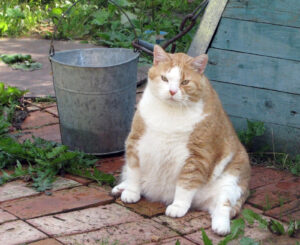By Beth Leermakers
Is Fluffy too “fluffy”? Is Zorro under-tall? Being overweight isn’t healthy for your cat. In 2018 The American Veterinary Medical Association (AVMA) classified obesity as a disease — for good reason. Overweight cats are at greater risk for health problems — including diabetes, arthritis and urinary disease — and a shorter life expectancy.
About 60 percent of cats are clinically overweight or obese, according to The Association for Pet Obesity Prevention. One study found that only 10 percent of people with an overweight cat knew their cat was too heavy.
If your cat is underweight, that can be unhealthy too. Unexplained weight loss can be a sign of a serious disease. If your cat has been losing weight unexpectedly, visit your veterinarian.

Photo courtesy of Green Acres Kennel
How much should
your cat weigh?
The ideal weight for the average healthy cat is 10 pounds. Having said that, healthy cats (like people) come in a range of sizes and weights. Ideal size and weight can vary by breed. Maine Coons are bred to have medium or large frames and broad chests. These sturdy kitties may be healthy at 20 lbs.
Veterinarians developed the Body Condition Score chart to account for frame size and lean muscle mass when determining ideal body weight. You’ve probably seen this chart, with its 9-point scale ranging from 1 (emaciated) to 9 (obese) — in your veterinarian’s exam rooms. Your cat should be a 4 or 5. To evaluate your cat’s weight, you’ll need to touch him as well as view him from several angles. You should be able to feel your cat’s ribs without searching through a layer of fat. Cats should only have a thin layer of fat over their ribs. When viewed from above, your cat should have a slight hourglass shape as the abdomen tucks in slightly behind the rib cage. When viewed from the side, your cat’s body should only very slightly tuck up behind the rib cage and have a very minimal abdominal fat pad.
Ask your veterinarian where your cat falls on the Body Condition Score chart. Don’t assume that your cat’s weight is fine if your vet doesn’t mention it. Some vets — perhaps worried about offending pet parents and possibly losing customers — are reluctant to talk about weight.
How to Help Your
Cat Lose Weight
Body weight is regulated by genetics, hormones and environmental factors. Consult your vet to develop a safe, effective weight loss plan. Here are a few vet-recommended strategies:
Implement portion control. Put away the bottomless food bowl. Leaving dry food out all the time is the single biggest contributor to obesity in cats (and dogs), according to Dr. Elizabeth Arguelles of Just Cats Clinic in Reston, Va. Instead, feed your cat several small meals per day. According to Dr. Arguelles, the best way to keep your cat from becoming obese is to feed canned food. If you can’t do that, measure the dry food every day. The portion guidelines on food bags are often wrong. Dr. Arguelles says that most cats only need 1/2 cup of kibble per day.
Consider changing your cat’s food. He may need a weight management or metabolic diet (higher in protein and fiber) to get all the nutrition he needs and to feel full longer.
Consult your veterinarian to determine what and how much to feed Fluffy. Your vet can help you calculate how many calories she needs to lose weight and satisfy her hunger.
Slow and steady weight loss is the way to go. Your kitty should lose 1/2 to 1 pound per month. Faster weight loss can lead to fatty liver disease.
Turn meal time into a hunt. Use a food toy or prey-like feeding device so your cat has to hunt for her dinner. Check out the PetSafe SlimCat Interactive Cat Feeder for inspiration. Doc & Phoebe’s Cat Co. Indoor Hunting cat feeder kit contains three toy mice that you fill with your cat’s food, then hide around your house so Fluffy has to work for her breakfast.
Add exercise to your cat’s daily routine. Schedule two 5-minute play sessions every day. Try feather wand toys, plush toys and cat tunnels. Many kitties enjoy playing with simple household items like toilet paper rolls or empty boxes. I’ve seen a few cooperative cats walking on a leash. Good luck with that one!
By using a 3-pronged approach — portion control, turning mealtime into a hunt and increased exercise — you can help Fluffy slowly transform into a svelte, healthy cat and bond with her while you’re at it.
Have fun!
